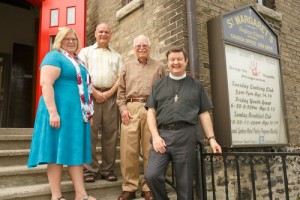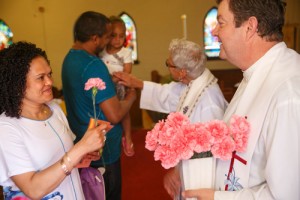
By Stuart Mann
A resource created by the diocese to help parishes with stewardship is showing significant results after only two years.
Of the 16 parishes that took part in the Growing Healthy Stewards program in 2013 and 2014, almost all are seeing increases in their offertory giving, FaithWorks contributions and pre-authorized giving. One church even credits the program with helping boost attendance.
“I would heartily endorse it,” says the Rev. Mark Gladding, incumbent of St. Margaret, New Toronto.
Growing Healthy Stewards is a year-round stewardship education program. One of its unique features is that it is coached. Each parish is teamed with an experienced lay volunteer who has a proven track record of leading stewardship in their own parish.
Another important aspect of the program is that each component has been tried and tested by parishes in the diocese. Over the past 10 years, more than 100 parishes have used various parts of the program. Based on their feedback, the material has been revised and collected into one manual.
Assisted by their coach, parishes in the Growing Healthy Stewards program work through the manual, which includes strategies for such things as introducing legacy giving, running an outreach campaign, celebrating gifts of time and talent, preparing a narrative budget and holding an intentional giving campaign. Some of the most innovative strategies, such as a “relay” of pledge cards from house to house, come from the parishes themselves.
“The program has been great,” says Mr. Gladding. “It gives you a plan to follow and it’s really simple.”
After two years in the program, St. Margaret’s has achieved considerable success. By the end of 2014, the church’s offertory givings were 14 per cent higher than budgeted and its contributions to FaithWorks had doubled. The average annual gift was $2,000 – this in a neighbourhood that has an after-tax household income of $52,663. Participation in pre-authorized giving increased by 36 per cent.
Not only has the church’s revenue gone up, but so has its average Sunday attendance, as it puts more time and effort into cultivating new members. “When you begin to focus on stewardship, you want to make sure that everyone has the ability to contribute,” says Mr. Gladding. “When a new person comes now, it’s not very long before someone is asking them if they would like to become a member of St. Margaret’s.”

He says the program has given parishioners more confidence to talk about giving and a deeper understanding of the church’s mission. Some members have given sermons on stewardship. “That changes how people look at each other, when someone is brave enough to preach a sermon on Sunday morning. That’s been a really good thing.”
Another church that has benefitted from the program is St. Timothy, North Toronto. Its offertory givings in 2014 were 10 per cent above budget and its participation in pre-authorized giving increased from 28 per cent in 2012 to 54 per cent in 2014 – a considerable increase given that those who sign up for pre-authorized giving usually give about 30 per cent more than they would by using envelopes or the open plate. The church’s support for FaithWorks has also increased by 27 per cent.
“The program provides a structure, so you don’t have to invent one,” says the Rev. Canon Gregory Symmes, incumbent. “Often in stewardship, we know the language but we’re not quite sure where to start or have the confidence, and this helps us with that.”
He says the program helped the church set realistic and tangible goals and then work towards them in an intentional way. “I’ve never gone home after hearing a good sermon and said to my wife, ‘Honey, lets increase our givings to the church.” It just doesn’t happen that way. But it does when we’re asked to consider if we would sign up for pre-authorized giving or increase our donations to hire a new staff person or put in an elevator or accomplish more. Vision inspires.”
Gordon Longman, a member of St. Thomas, Brooklin, is one of 14 coaches in the program and enjoys working with the parishes. “When I meet with the parishes, I ask about where they are and what they have done, and then we see what aspects of the program should be done next.”
He says the program does not offer a cookie cutter solution. “You can’t just impose it on the church. What I continually say is, ‘I am here as a consultant to help you manage your situation. It’s your program, not mine. The diocese has ideas and experience and processes that could help you, but it’s up to you to decide which ones you want to do.’ After that, I’ll give them whatever encouragement and follow-up is needed. It’s a co-operative process.”
Churches that sign up for the program must commit to following the manual as closely as possible, with some minor variations allowed. Each member of the parish’s stewardship committee must complete a personal stewardship audit and commit to a life of generous stewardship. All of the committee members, including the incumbent, need to become boosters of the program and lead by example, including speaking from the pulpit about discipleship and the importance of stewardship.
“It is a big commitment, but anything worthwhile requires a commitment,” says Peter Misiaszek, the diocese’s director of Stewardship Development. “If you can muster together, at minimum, four people to do the program, you can do it. When you start seeing the results, that will retain a high level of commitment.”
In return for signing up, the parish will be teamed with a coach who will meet with the parish’s stewardship committee at least four times a year to evaluate progress, plan activities and answer questions. At the beginning of the process, the parish’s current stewardship practices will be assessed, with an aim to improving them over the year. The parish will also have access to Mr. Misiaszek and other professionals in the Stewardship Development office.
For more information about the program, contact Peter Misiaszek, director of Stewardship Development, at pmisiaszek@toronto.anglican.ca. Also visit the Stewardship Development page.